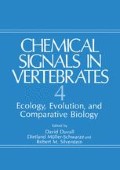Abstract
A number of chemical exudates originating from invertebrates and vertebrates are released under stressful environmental conditions. They are variously defined, but are known generically as “alarm signals,” chemosignals released by one or more individuals to affect the behavior and physiology of conspecifics (von Frisch, 1938; Muller-Schwarze et al., 1984; Pfeiffer, 1963). These chemicals can cause exploration and investigation (Jaffe and Puche, 1984; Sonenshine, 1985), hesitation and physiological signs of frustration (Courtney et al., 1968; Herreid and Mooney, 1984), immobilization and hiding (Rottman and Snowdon, 1972; Carr et al., 1970), flight and dispersion (Stevens and Gerzog-Thomas, 1977; Hornbuckle and Beall, 1974; Ressler et al., 1968), and social mobilization and attack (Cherix, 1983). The environmental features which provoke the release of such chemicals are diverse, but usually involve stimuli of potential danger, such as novelty, social intrusion or physical insult. Generally, among higher vertebrates the body source of these chemicals is unknown and no compounds have been isolated and identified.
Access this chapter
Tax calculation will be finalised at checkout
Purchases are for personal use only
Preview
Unable to display preview. Download preview PDF.
References
Carr, W. J., Martorano, R. D. and Krames, L., 1970, Responses of mice to odors associated with stress, J. Comp. Physiol. Psychol., 71: 223.
Cattarelli, M. and Vigouroux, M., 1981, Evaluation des reactions émotionnelles déclenchees par des odeurs a signification biologique chez le rat au cours d’un conditionnement opérant, Physiol Behav., 27: 445.
Cherix, D., 1983, Intraspecific variation of alarm pheromones between two populations of the red wood ant Formica lugubris (Zett.) (Hymenoptera, Formicidae), Schweiz. Entomol. Gesamte, 56: 57.
Courtney, R. J., Jr., Reid, L. D., and Wasden, R. E., 1968, Suppression of running times by olfactory stimuli, Psychonom. Sci., 12: 315.
Cushing, B. S., 1984, A selective preference by least weasels for oestrus vs. dioestrus urine in prairie deer mice, Anim. Behav., 32: 1263.
Davis, S. F., Thomas, R. L., and Prytula, R. E., 1981, The development and maintenance of odor-based double-alternation responding under conditions of Thorazine and Elevil injection, Anim. Learn. Behav., 9: 551.
Drickamer, L. C., and Shiro, B. C., 1984, Effects of adrenalectomy with hormone replacement therapy on the presence of a sexual maturation- delaying chemosignal in the urine of grouped female mice, Endocrinology 115: 255.
Fanselow, M. S., 1985, Odors released by stressed rats produce opioid analgesia in unstressed rats, Behav. Neurosei., 99: 589.
Frisch, K. von., 1938, Zur Psychologie des Fischschwarmes. Naturwissenchaften, 26: 601.
Gosling, L. M., and Petrie, M., 1981, The economics of social organization, in: “Physiological Ecology: An Evolutionary Approach To Resource Use,” C. R. Townsend, and P. Calow, eds., Blackwell Scientific Publications, Oxford.
Herreid, C. F., II and Mooney, S. M., 1984, Color change in exercising crabs: Evidence for a hormone, J. Comp. Physiol. B, 165: 207.
Hornbuckle, P. A., and Beall, T., 1974, Escape reactions to the blood of selected mammals by rat, Behav. Biol., 12: 573.
Jaffe, K., and Puche, H., 1984, Colony-specific territorial marking with the metapleural gland secretion in the ant Solenopsis geminata (Fabr), J. Insect Physiol., 30: 265.
Jones, R. B., and Nowell, N. W., 1973, Aversive and aggression-promoting properties of urine from dominant and subordinate male mice, Anim. Learn. Behav., 1: 207.
Mackay-Sim, A. and Laing, D. G., 1980, Discrimination of odors from stressed rats by non-stressed rats, Physiol. Behav., 24: 669.
Mackay-Sim, A., and Laing, D. G., 1981a, Rats’ responses to blood and body odors of stressed and non-stressed conspecifics, Physiol. Behav., 27: 503.
Mackay-Sim, A. and Laing, D. G., 1981b, The sources of odors from stressed rats, Physiol. Behav., 27: 511.
McGlone, J. J., 1985, Olfactory cues and pig agonistic behavior: Evidence for a submissive pheromone, Physiol. Behav., 34: 195.
Muller-Schwarze, D., Altieri, R., and Porter, N., 1984, Alert odor from skin gland in deer, J. Chem. Ecol., 10: 1707.
Pfeiffer, W., 1963, Alarm substances, Experientia, 19: 113.
Ressler, R. H., Cialdini, R. B., Ghoca, M. L., and Kleist, S. M., 1968, Alarm pheromone in the earthworm Lumbricus terrestris, Science, 161: 597
Rottman, S. J., and Snowdon, C. T., 1972, Demonstration and analysis of an alarm pheromone in mice, J. Comp. Physiol. Psychol., 81: 483.
Sonenshine, D. E., 1985, Pheromones and other semiochemicals of the acari, Amer. Rev. Entomol., 30: 1.
Stevens, D. A., and Gerzog-Thomas, D. A., 1977, Fright reactions in rats to conspecific tissue, Physiol. Behav., 18: 47.
Stevens, D. A., and Saplikoski, N. J., 1973, Rats1 reactions to conspecific muscle and blood: Evidence for an alarm substance, Behav. Biol., 8: 75.
Sullivan, T. P., and Crump, D. R., 1984, Influences of mustelid scent gland compounds on suppression of feeding by snowshoe hares (Lepus americanus) J. Chem. Ecol., 10: 1809.
Thiessen, D. D., and Kittreil, E. M. W., 1980, The Harderian gland and thermoregulation in the gerbil (Meriones unguiculatus), Physiol. Behav. 24: 417.
Vernet-Maury, E., 1980, Trimethyl-thiazoline in fox feces: A natural alarming substance for the rat, in: “Olfaction and Taste VII,” H. Van der Starre, ed., IRL Press, Ltd., Washington, D.C.
Weldon, P. J., 1982, The evolution of alarm pheromones, in: “Chemical Signals In Vertebrates 3,” D. Muller-Schwarze, and R. M. Silverstein, eds., Plenum Press, New York.
Author information
Authors and Affiliations
Editor information
Editors and Affiliations
Rights and permissions
Copyright information
© 1986 Plenum Press, New York
About this chapter
Cite this chapter
Thiessen, D.D., Cocke, R. (1986). Alarm Chemosignals in a Meriones Unguiculatus: Prey-Predator Interactions. In: Duvall, D., Müller-Schwarze, D., Silverstein, R.M. (eds) Chemical Signals in Vertebrates 4. Springer, Boston, MA. https://doi.org/10.1007/978-1-4613-2235-1_38
Download citation
DOI: https://doi.org/10.1007/978-1-4613-2235-1_38
Publisher Name: Springer, Boston, MA
Print ISBN: 978-1-4612-9310-1
Online ISBN: 978-1-4613-2235-1
eBook Packages: Springer Book Archive

